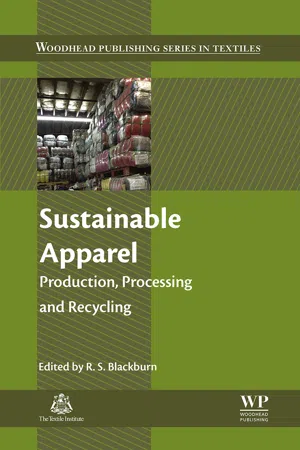Lately substitution of hazardous substances has become a hard task for fabric finishing companies. Substances such as easy-care products, fluorocarbons for water- and oil-repellent properties, various flame retardants (halogen or phosphor-based), plasticizers in PVC coatings and solvents such as dimethylformamide (DMF) in polyurethane (PU) coating formulations have been proposed for or are already restricted or banned by REACH and ecolabels.
Besides the need for alternatives, it is also necessary to be able to detect the restricted or banned substances in textiles and to be able to distinguish them from those that are allowed to be used. Efforts are being done in our institute to develop highly differentiating methods for those phthalates (Van de Vyver, 2012), halogenated- and phosphorous-based flame retardants that are restricted. The methods developed are discussed in the related standardization workgroup CEN/TC248 WG26 “Textiles—Test methods for analysis of EC restricted substances.”
1.3.1 Easy-care finishes
Easy-care is the property associated with an improved maintenance of cellulosic-based textiles, especially with respect to wrinkling and thus ironing. Cellulosic fibers have the disadvantage of lack of dimensional stability. The discovery of the effect of formaldehyde reacting with cellulose was the basis for the development of easy-care finishes.
However, concerns arose regarding the health and safety of formaldehyde. Formaldehyde is a volatile organic compound (VOC). Exposure to formaldehyde happens mainly through inhalation, but can also occur by absorption through the skin. Workers may be exposed during direct production, treatment of materials, and production of resins. Consumers may be exposed to formaldehyde through easy-care textiles.
Worldwide regulations are defined for formaldehyde in textiles; there is, however, no harmonization of these regulations in the different countries. Some general rules do apply. Depending on whether direct skin contact occurs, different limits on formaldehyde levels are set (i.e., higher in the case of skin contact). In most countries a differentiation is made between clothing for children or babies, clothing for sensitive people, and clothing for other people. In some cases labeling is necessary to inform the consumer that the clothing contains formaldehyde and that is has negative effects on health. Also OEKO-TEX® set limits to formaldehyde (see Table 1.1).
Table 1.1
Thresholds set for formaldehyde levels by OEKO-TEX®
| OEKO-TEX® class | Formaldehyde (mg/kg)Japanese LAW 112 | Formaldehyde emission of volatiles (mg/m3) |
| Class I—baby | < 16 | 0.1 |
| Class II—direct skin contact | 75 | 0.1 |
| Class III—no direct skin contact | 300 | 0.1 |
| Class IV—decoration material | 300 | 0.1 |
Formaldehyde has indeed been found to have adverse effects on the health of humans, for example, irritation to the eyes, nose, throat or skin; it can be a source of coughing or interfere with breathing, and has been classified as a carcinogenic substance (at long-term exposure of high levels). Medical studies have shown a relationship between formaldehyde exposure and nasal cancer, nasopharyngeal cancer, and leukemia. The International Agency for Research on Cancer (IARC) classified formaldehyde as a human carcinogen. Studies by the U.S. Environmental Protection Agency (EPA) and the National Cancer Institute (NCI) have found formaldehyde to be a probable human carcinogen and workers with high or prolonged exposure to formaldehyde to be at an increased risk for leukemia (particularly myeloid leukemia) and brain cancer. In June 2004, IARC reclassified formaldehyde from “probably carcinogenic to humans” to “carcinogenic to humans” (IARC, 2004).
The EU classification defines the risk phrase “Toxic by inhalation, in contact with skin and if swallowed. Causes burns. Limited evidence of a carcinogenic effect. May cause sensitisation by skin contact. [R:23/24/25-34-40-43]”—Defined in Annex II of EU Directive 67/548/EEC as amended by EU Directive 2001/59/EC. Formaldehyde was included in the substance evaluation list in 2013. On February 29, 2012, ECHA (the European Chemicals Agency) published the Community Rolling Action Plan (CoRAP) in which formaldehyde was included. CoRAP is a list of chemical substances that need to be evaluated with the aim to define whether policy measures are required to ensure an adequate management of exposure (for instance for formaldehyde) by workers and consumers.
In the United States, the Occupational Safety and Health Administration (OSHA) defined limits to protect workers when being exposed to formaldehyde in Title 29 (concerning labor) of the Code of Federal Regulations (CFR) PART 1910–Occupational Safety and Health Standards paragraph, 1910.1048 Formaldehyde. The standard is valid for the occupational exposure to all kind of formaldehyde products (gas, solutions, and materials releasing formaldehyde). The permissible exposure limits (PELs) for formaldehyde in the workplace are set to 0.75 ppm during a time period of 8 h (time-weighted average or TWA). For short-term exposures (15 min) th...
